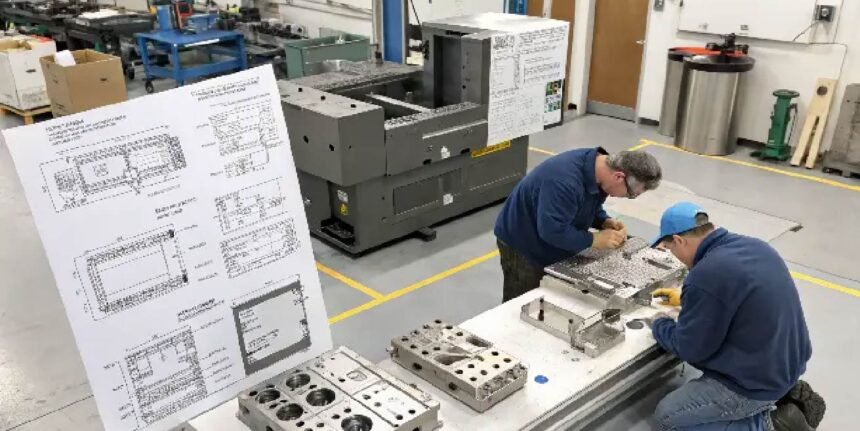One of the commonest mass production approaches to plastic products is an injection mold. Injection molding can be found everywhere: there are toys, medical tools and equipment, and even car parts created via injection molding. So what makes this process so effective?
An injection mold, parts, and components are the answer. These are the parts that constitute the mold structure and enable the plastic to be molded with expediency as well as precision.
What is an Injection Mold?
An injection mold is a high-precision instrument applied during the plastic injection molding procedure. It is steel/aluminum-based, and it has a series of parts that enable plastic to flow, form, cool, and extrude the way it is supposed to.
Each mold is designed uniquely to fit the product design. The build and components of the mold are the determinants of the quality product in the end plastic part.
Primary Parts of an Injection Mold
By knowing the major parts of an injection mold, you too will be able to realize how each part is crucial. The following are the most critical injection mold parts:
1. Mold Base
This is the key frame that consolidates all other parts. It includes:
- Top plate
- Bottom plate
- Support plate
The tool is granted strength and togetherness by the mold base.
2. Hole and Calix
And the principal shaping surfaces of the mold are these:
- Cavity (female part) -forms the outside of the product.
- Core (male part) A core (male part) creates an inner shape of the product
- On injection, the plastic passes between the cavity and core to make the final part.
3. Sprue and Gat, and Runner
These are the parts in which the molten plastic will be directed to the mold.
- Sprue: the principal through which plastic flows
- Runner: puts the plastic on every spot of the mold
- Gate: the last opening where the plastic goes inside the cavity
The right design will mean easy movement and less wastage.
4. Ejector System
The part should be taken out of the mold after it a cooled. This is done by the ejector system.
It includes:
- Ejector pins
- Ejector plate
- Return pins
As the mold opens, the ejector pins vertically force the plastic piece out.
5. Cooling System
The cycle time should remain low by ensuring that the plastic is cooled faster. Its mold has:
- Cooling channels
- Water lines
- Air conditioning units
- Part quality and warping can be improved through a good cooling system.
Other Needed Components of Molds
- Guide Pins, and Bushings- perfect fit; alignment
- Slide and Lifter- to produce an undercut [or side hole]
- Clamping Plate-this holds the mould to the machine.
- Springs- assist in the movement of the ejector plates
- Vents- permit the ejection of air on the mold cavity
Every component has a particular role to make sure that there is a smooth molding process.
Why Bother With Good Mold Parts?
Alright, here’s the deal—skimp on mold parts, and you’re just begging for headaches later. Quality stuff? It lasts way longer, so you’re not constantly swapping things out. Plus, your parts come out looking sharp, not all wonky and off-size.
Nobody wants a machine that’s always breaking down, right? Solid mold parts mean less time fixing stuff and more time cranking out product. Maintenance bills? Yeah, they drop. And your cycles just run smoother and faster. It’s kinda wild how much cash you save by not being cheap up front. Seriously, just go for the good stuff and thank yourself later.
Special Injection Mold Patterns
Molds are not equal. They are made either in a single cavity or multiple cavities, depending on the number of parts produced at a time.
There are those molds that require extraordinary features such as:
- Interchangeable inserts
- Hot runners
- Unscrewing mechanisms
- The success of obtaining what you want lies in working with a reputable mold maker.
The Best Plastic Injection Mold Service offers expert aid in the process of mold creation, in case you need that. They provide complete design, engineering, and tooling that are specific to your product.
Maintenance of mold parts
Any mold requires regular maintenance to maintain its good condition. This includes:
- Cleaning the core and the cavities
- Ejector pin checks and renewals
- Greasing moving components
- Wear and damage inspection: Inspecting for wear or damage
A mold that has been well taken care of can have a life span of more than a million cycles.
New Technology in Mold Parts
More sophisticated molds are now being created with:
- Hot runner systems – increase efficiency.y
- Modular parts – conveniently fixable or exchangeable
- High-velocity expelling devices – shorter cycle rates
- The upgrades make high performance and extended mold life possible.
The Injection Mold Parts experts make it possible to read more about particular components and services.
Conclusion
Injection molding is very much dependent on a variety of accurate components that are harmonized together. The cavity and the core, the cooling system, and the ejector are all necessary. Being aware of these injection mold parts and components assists you in making decisions when it comes to mold design, maintenance, and production.
Choosing your parts and good service providers is one of the things you should do, whether you are undertaking a new project or upgrading your current mold. This will lead to better products, less downtime, and increased profitability after all.







